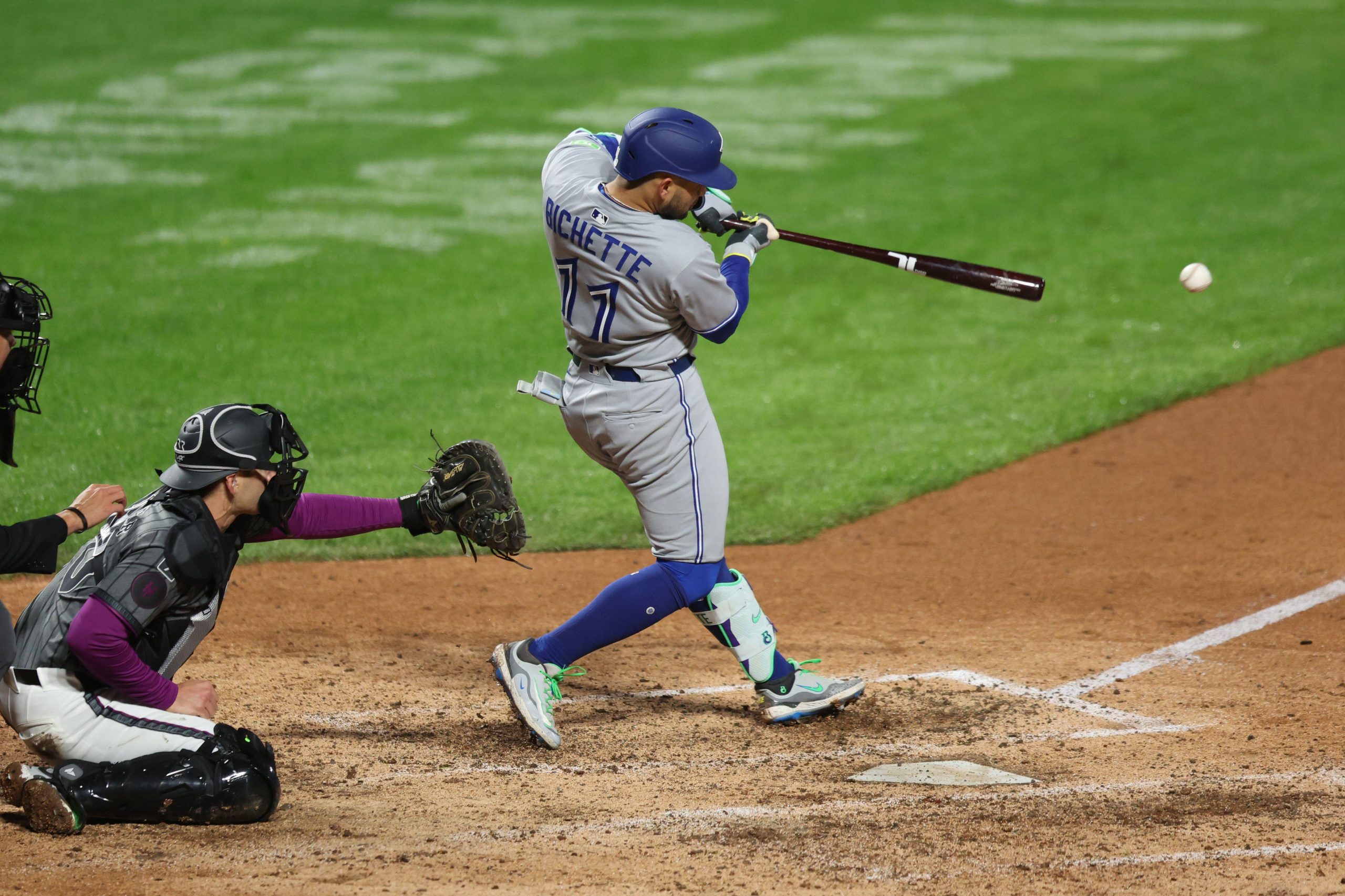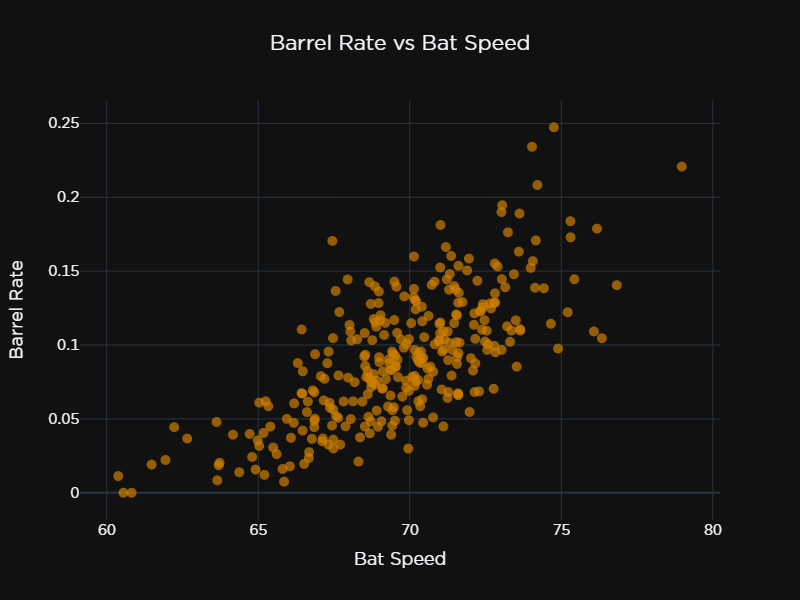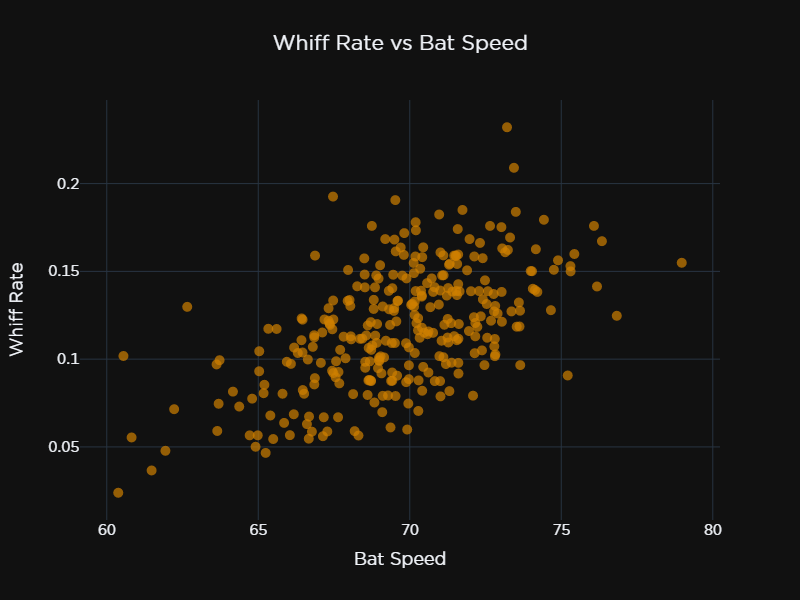The Bat Speed Wars rage on. What will end them?

There is no end in sight to the Bat Speed Wars. We are not sure when we will be able to return home from the front.
A subplot during this World Series included a back-and-forth on social media regarding the merits of emphasizing swing speed.
The debate reached a boiling point with the Toronto Blue Jays playing in their first World Series in 32 years, a development tied in large part to internal improvement. The Blue Jays won the AL pennant not due to external additions but because their returning position player group improved at least in part — and I argued in large part — due to increased bat speed.
Sure, there was better health among players like Bo Bichette. But there was real, underlying skill growth. The Jays notably swing their bats faster and improved that skill throughout the season. The Jays rank fifth in the postseason field with a 71.9 mph average bat speed. They were among the laggards a season earlier.
This improvement came under first-year hitting coach in David Popkins, a former Driveline client and Dodgers hitting coordinator, who brought in a new intent-driven approach.
It’s not just the Blue Jays.
The World Series champion Los Angeles Dodgers have also had a selection of hitters train at Driveline in recent years. The Dodgers are among the clubs most interested in adopting the best player development practices. That includes bat-speed training.
This was a World Series meeting between two excellent organizations interested in swinging with more speed – not less. That says something, and says it loudly.
After all, if a hitter’s other skills remain constant – contact percentage, swing decisions, batted-ball quality, etc. – increasing bat speed raises their offensive production. Physics remains undefeated. Swinging a bat faster will cause the ball to exit with more speed and travel further.
We have proven at Driveline that hitters can improve their bat speed much like pitchers can improve their pitching velocity through constraint-based training, and that it can raise a player’s overall production. Yet, the merits of bat speed and training regimens to enhance it have doubters – including some very loud skeptics on social media platforms.

So, why does it remain controversial? In this piece we will address three big misconceptions:
- The argument that adding bat speed means missing the ball.
- The idea that contact quality is more important than bat speed.
- And the difference between swinging fast and swinging hard.
But let’s first begin with making something clear: valuing bat speed is not a new concept.
Hank Aaron, Ted Williams, Babe Ruth, and Willie Mays all undoubtedly possessed plus bat speed. They had intent to do damage.
Swinging a bat fast has always been a positive attribute. Again, physics.
Oakland A’s slugger Brent Rooker, who stopped by Driveline’s Arizona facility recently for an assessment, echoed similar sentiments.
“The fact that the idea of ‘swinging the bat faster is better’ is considered new age analytical thinking is insane,” Rooker wrote on X. “Gaining speed/power/force production has been beneficial for every athlete in every sport since the beginning of time. Pitchers who throw harder have higher ceilings. Golfers who swing the club faster have higher ceilings. Running backs who run faster have higher ceilings. Basketball players who jump higher have higher ceilings, etc. Does it mean that those who are bigger/faster/stronger will automatically be better? Of course not. Skill, mental makeup, competitive edge, preparation and a thousand other things all play a massive part in overall success, but the fact that being more physically explosive and producing more force gives you a greater chance for success has always and will always be true.”
The idea that moving faster is beneficial for an athlete – any type of athlete – is not new.
So, why the push back from some corners of the baseball world?

I asked Driveline director of hitting Tanner Stokey.
“I think the thing to start with is that that data hasn’t been public for very long – we’re looking at two and a half years now that the season is over,” said Stokey of the MLB-level data. “There’s a lot of people that don’t even know it’s there and have never looked at it .”
Bat speed is not new but quantifying it is.
And if we can measure something, then we can build better training regimens. It’s not any different than training velocity once we had reliable radar gun readings.
With just about anything new, there is will be pushback. The ancient Greek polymath Eratosthenes proved the Earth was round more than 2,000 years ago yet there are still doubters. There will always be doubters. The key with any valuable breakthrough is reaching a tipping point of wide acceptance.
That requires evidence, education, and communication to overcome misconceptions.
Driveline hitting coordinator Travis Fitta says empathy is key in messaging.
“Be empathetic to the fact that people don’t know what they don’t know,” Fitta said. “If you start looking at metrics individually – like bat speed in a vacuum – it’s very easy for people to start making assumptions of the metric based on what they know from their own playing career, or what they’ve seen, or what some guy down the street has told them about swinging fast.
“(Buy-in) is probably going to require more patience.”
Empirical evidence can accelerate buy-in, too.
So, let’s turn to the most popular misconception related to the topic: that increasing bat speed means missing the ball.
The Blue Jays proved this season that not only is bat speed improvement important, but that it does not have to come at the expense of bat control.
Not only did Toronto enjoy some of the greatest bat speed and exit velocity gains this season but they improved from a very good contact-hitting last season (6th lowest strikeout rate at 20.3% in 2024) to the become the best contact team this season (lowest MLB strikeout rate at 17.6%).

Bat speed, contact and contact quality do not have to be competing against each other in a zero-sum game.
A player can increase their overall pie of offensive production through training bat speed in game-like environments. It can even help contact quality and swing decisions by giving hitters more margin for error.
“I think the Blue Jays are not just this gigantic poster boy for the fact that bat speed works,” Fitta said. “These guys are making better decisions overall, because they’re probably trained in a way that’s appropriate to it. They also probably have really good scouting reports; some really good plans being made. But somebody, somewhere decided to prioritize the fact that these guys can move cleanly, swing the bat fast, and make really good decisions.”
Beyond the Blue Jays, the relationship between bat speed and whiff rate was fairly weak in MLB wide in 2025 (R-squared value of .27).

Hitting is hard. Modern pitching is filthy. While we value pulling the ball in the air at Driveline – that’s where optimum batted-ball results reside – we do not only train batters to only target the pull side. We train ball flights to all parts of the field, too.
While we want hitters to fire off their A swings as often as possible, and we spend plenty of training economy toward that end, but we practice B swings, too.
Consider what Stokey told me during a conversation earlier this year:
“As much as we talk about bat speed and pulling the ball in the air, you’d be pretty surprised how many times we hit it hard and low to the opposite field,” Stokey said. “Backing up the point of contact, catching the ball deep, and sequencing well enough to be able to maintain posture and get the barrel on plane behind it … Hard and low to the opposite field – it’s going to help them reverse engineer a way to have a good efficient path to when they catch the ball out in front.
“A lot of it comes back to ways to increase your margin for error as a hitter.”
A second popular misconception is contact quality is more important than bat speed, that those two variables are independent of each other.
To be clear, no one is arguing against the idea that contacting a ball at ideal angles is not important. No one is advocating for an in-field pop-up, or weak roller.
But we want to combine faster movement with contact quality.
And what’s clear is improving bat speed is an overwhelming positive attribute.
Springer added 1.9 mph in bat speed in 2025.
And the percentile rankings show the improvement in production climb along with it.
When your Fast Swing Rate % jumps 18%, you can expect to see production tick along with it.
+8 doubles
+13 home runs
+131 points in xwOBAcon https://t.co/z9dMRabza4 pic.twitter.com/sjQPWzqzcO— Travis Fitta (@TravisFitta) October 21, 2025
Stokey noted that the best MLB hitters are overwhelmingly ones with above average bat speed.
Consider that of the top 20 hitters by wOBA this season, 18 of them possessed above-average bat speed.
There are outliers but Stokey noted they typically enjoy “some combination of elite ball fight, elite swing decisions, elite contact ability.”
Successful hitters will possess a number of skills, but moving the bat fast is typically an important driver.
The correlation between bat speed and exit velocity in the majors this season was significant (R-squared value of .46), as was the relationship between bat speed and barreled, batted-ball events (R-squared value of .48). Those marks were each stronger than the correlation between bat speed and whiff rate (R-squared value of .27) in 2025.
Another way of looking at it: more good than bad happens when the bat moves faster.
The hard truth for amateur hitters with bat speed deficiencies is it will be difficult for them to play in college let alone reach professional baseball. If a college player has a relative deficiency, it becomes more difficult to be drafted. If a minor leaguer lacks bat speed, it’s more a challenge to reach the majors, and so on.
Even veteran stars like Mookie Betts and Nolan Arenado have worked with us and enjoyed spike seasons in their 30s in part because of increasing bat speed.
Bat speed declines with age as we’ve studied. Arenado is returning to work with us this offseason. They know bat speed matters. Arenado showed up a few years ago at Driveline because Joey Votto told him his rebound season was tied to improving bat speed.
That brings us to the final of the Big Three misconceptions: the difference between swinging hard and swinging fast.
The anti-bat speed crowd will cherry pick examples to provide what they believe is evidence in the case against training and improving bat speed. It’s selective editing.
“Pushback comes from someone who will see somebody just like swinging out of their shoes and practice, and it’s like ‘No shit that’s not gonna translate to the game, but we’re not actually trying to get somebody to take that type of swing into the game,’” Stokey said. “There’s a big difference in swinging hard and swinging fast.”
It’s like sound-bite culture in journalism where a reporter or media outlet will provide a selected interview snippet without providing context.
Swinging fast is about increasing bat speed. Swinging hard is swinging out of one’s shoes.
Fitta explains that there are different types of training programs, and different types of training days. Training is tailored to the individual, and to where they are in the offseason or in-season.
“I’ll tell you the best and worst thing that has ever happened to Driveline, and I say these two names in the same breath: Robbie ‘Byrdman’ Tenerowicz and Travis Bazzana,” Fitta said. “Two guys who fundamentally understand there are days that they are going to have to swing this bat like an asshole to try and build their motors, and then there are days where they have to prioritize ball flight movement and making this speed subconscious.
Congrats to Robbie Tenerowicz aka Byrdman on a great year being named a Mariners Organization All-Star after putting up these numbers .282/.391/.451, 19 HR, 101 RBI between AA/AAA 🔥 Listen to his incredible story and how he got here 🙌 pic.twitter.com/PBj744lInW
— Driveline Baseball (@DrivelineBB) November 1, 2023
“But what does everybody take away from it? They find the one clip of Byrdman, or the one clip of Bazzana, or they find the one clip of a random Driveline hitter we post swinging out of their ass, moving fast, being celebrated by teammates. That’s a training environment. This is not the game. I think this is where people misunderstand this. They’re locked into that habit of ‘You gotta train to play the game.’ But the problem is when you look across sports, hockey players are training beyond the game – they are making it way more intense. Football players are training way more intensely than the game. Basketball? Training more intensely than the game.”
Baseball? Not so much.
We coach hitters to not just swing faster but to do so in a way that ensures translating it to game competition. The idea is to make practice more difficult than the game. Swing hard in practice so you can swing fast in games.
We want players to build their engines. We do not want out-of-control swings to appear in games. We do not even want players swinging at 100% max effort in games.
We’ve found the best batted-ball outcomes occur when a batter swings at 90% of his bat speed, which suggests there is some trade off in terms of sacrificing maximum speed for barrel accuracy.
But that also means raising a player’s bat-speed floor, increasing their median bat speed, is incredibly important. It’s critical to build up a player’s “engine” so their 80-90% swing can do more damage.
“Baseball is still the sport one where people really do believe that if I just do flips and do some confidence BP, and my coach tells me ‘Hey, hit ground ball over here, and move them over here’ then suddenly I’m gonna get ready to face Shohei Ohtani or Aroldis Chapman,” Fitta said.
Despite the data, despite the success stories, there are still numerous skeptics.
Some examples from recent days:
- This only matters if you can hit when the lights come on! Not a fan of this type of training. I’ve seen a lot of incredible 5 o’clock hitters(BP) that never showed up when the lights came on.
- Bat speed does NOT measure how good a hitter is or if he can hit! Why emphasize it?
Counter point:
10 fastest swings from game 1 of the World Series pic.twitter.com/GoKQwswp99
— Tanner Stokey (@Tstokey) October 25, 2025
If you are a player or coach who is reluctant to change, to accept bat speed is important – you are increasingly going to be left behind. That’s the math. That’s the physics.
Unfortunately, too many nonbelievers still exist. More open-mindedness is required.
“As a coach now in my 10th year, I’ve officially hit the Keanu Reeves point where I’m like ‘If you think one plus one equals three like, yeah, you’re absolutely right, dude,’” Fitta said. “I don’t have time to like argue that anymore. The ignorance at this point just like can’t be forgiven.”
If you’re a curious coach or ballplayer, the truth is out there.
Comment section